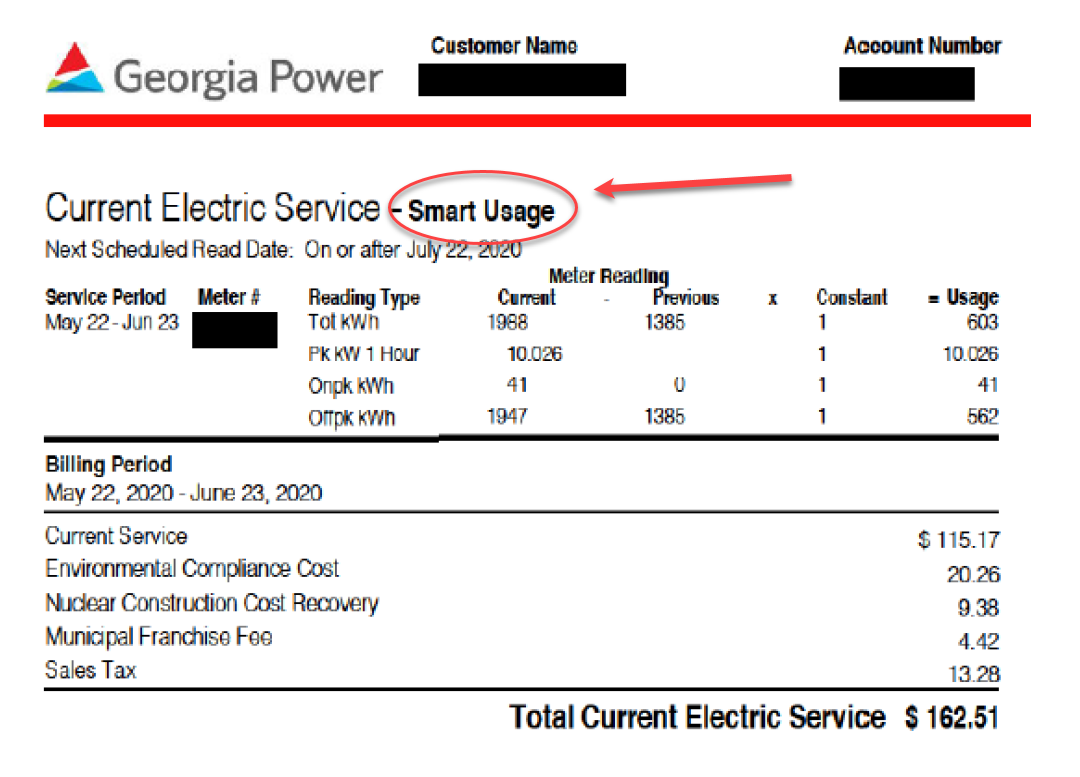Don’t Be Fooled: Georgia Power’s Smart Usage Rate is Bad
Have you moved into a newly constructed home, apartment or condo after January 1, 2021? Congratulations! It feels great to move into a brand-new place with brand new floors, appliances, fixtures and lighting.
Here is something that won’t feel great: you were default enrolled onto Georgia Power’s “smart usage” rate plan. This plan is indeed smart: for Georgia Power, that is. It’s a huge new source profits because this rate plan is MUCH more expensive than the traditional rate plan 95%+ of Georgia Power customers are on. Unless you live in a very large home, your electricity bills on the “Smart Usage” rate plan are 50-80% more expensive. Why is this happening?
On December 19, 2019, the Georgia Public Service Commission authorized Georgia Power to “default” customers moving into a newly constructed premises onto a rate plan they call “Smart Usage”, also known as a demand charge rate plan, beginning January 1 2021. You can ask for a traditional rate plan, but few people will know to do that. “Demand” means the maximum amount of power you use over a one hour period during the bill cycle.
And “Smart Usage” sounds good, doesn’t it? When something is called smart that mean it has digital features or is connected to the internet. People have a positive view of their smart phone, smart home, smart doorbell, etc., because of the features smart devices give them. But there is nothing “smart” about this rate plan.
Here is a list of what you will lose, or not have, on this “Smart” rate plan:
It is a complex rate plan not designed for consumers to understand. It violates 3 of 8 principles of rate design that every utility should respect. Georgia Power is the only utility in the nation default enrolling unsuspecting customers on the rate plan.
You must avoid hitting a maximum demand by using only one appliance at a time. There is no way to track or tell when that is going happen. You cannot control when your refrigerator defrosts.
Information about your maximum demand is not on your bill and you cannot get it from the utility call center.
There is no interactive online bill calculator, shadow billing, or any comparison tool to help you see the costs between the Smart Usage demand charge and the traditional rate plan.
You are not provided smart data like real time pricing, hourly usage, or any similar method to help you manage your demand charge.
There is no cap or bill protection for you on this rate plan even though the Georgia Public Service Commission has never allowed Georgia Power to default customers on it before.
You will not be allowed to unenroll from this plan for 12 months once enrolled.
Georgia Power, and Georgia Public Service Commissioners who authorized this rate plan like to say that customers could save money if they avoid using multiple appliances at the same time, but there are no studies that show that to be true. There are, however, plenty of studies that show such fees unfairly allocate grid costs to low-use customers in apartments and small homes.
But let’s pretend it’s true despite the lack of evidence: it is difficult for customers to avoid using multiple appliances at once. How do you know what everyone else in the household is doing? How do you manage appliances that turn off and on automatically like a refrigerator? If you had a smart home with smart devices and access to your hourly energy data it might be easy. But you don’t. No one does, because the Georgia Public Service Commission doesn’t require Georgia Power to provide such data..
Don’t use more than one!
Georgia Power, and Georgia Public Service Commissioners like to say that this rate plan is good because it encourages customers to avoid using electricity at expensive times of the day, also known as “peak”, which can help reduce system costs. Peak energy usually occurs on the hottest afternoon of summer months and IS very expensive for the utility (and thus, us).
However, the Smart Usage demand charge fee is not associated with peak usage. You pay for the maximum demand you used that bill period regardless of when it occurred.
Also, the Georgia Public Service Commission does not have goals for Georgia Power to reduce residential peak demand, like many states. If there was such a goal there are more affordable programs where consumers save money by helping reduce expensive energy use, like this example:
And this one, both from other utilities:
It widely known from research that consumers do not want or understand demand charge rate plans. The risk of consumer backlash is high, based on what happened in other states. Georgia Power flew an expert witness in from California, Dr. Ahmad Faruqui, who spoke eloquently about how to eliminate this risk:
“…it's a question of adjusting to a new house, new furniture, new air conditioning and so it comes with a different rate.”
Confused?
Go ahead - try to understand it: your demand charge fee is based on the maximum kWh usage you used over a one hour period during your bill cycle, multiplied by $8.21 /kWh. But that fee is hidden. You are encouraged to modify your behavior to lower a fee you cannot see and you don’t know when it occurred.
Why did the Georgia Public Service Commission allow it? Georgia Power, and Georgia Public Service Commissioners like to say that they enjoy a “constructive regulatory compact” – complicated words to mean one thing: the Georgia Public Service Commission gives Georgia Power whatever it wants with little regard for protecting consumers.
Not In Georgia
You have discovered you are on the “Smart Usage”
Demand Charge rate plan.
There are Several Things You Can Do
Part 2 Coming Next









